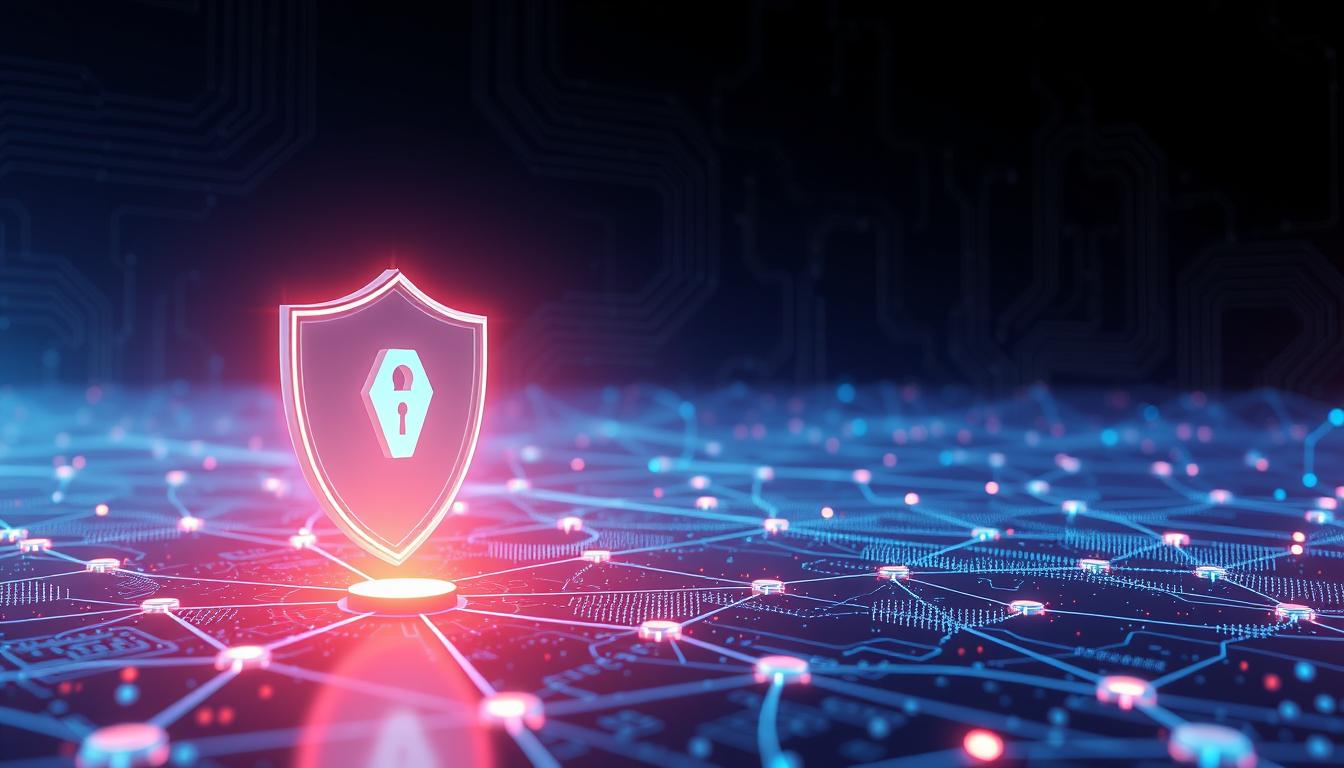In today’s digital age, where our lives have become increasingly intertwined with technology, the importance of cybersecurity cannot be overstated. According to a recent study, the global cost of cybercrime is expected to reach a staggering $10.5 trillion annually by 2025. This sobering statistic underscores the vast scale and impact of the threats we face in the digital realm.
This comprehensive guide will equip you with essential strategies and best practices to safeguard your digital assets and defend against the evolving threat landscape. From understanding the importance of cybersecurity to implementing robust security measures, this article will empower you to take control of your online safety and protect your digital world.
Key Takeaways
- Cybersecurity is crucial in the digital age to protect against the growing threat of cybercrime
- This guide will provide essential strategies and best practices to secure your digital assets
- Understand the evolving threat landscape and the consequences of cyber attacks
- Learn about network security essentials, data protection, and threat prevention measures
- Discover the importance of ethical hacking, vulnerability assessments, and risk management
- Cultivate security awareness to enhance your overall cyber resilience
- Gain the knowledge to protect your digital world and safeguard your online presence
Understanding the Importance of Cybersecurity
In today’s digitally-driven world, cybersecurity has become a critical concern for individuals, businesses, and governments alike. The threat landscape is constantly evolving, with cybercriminals devising ever-more sophisticated cyber attacks to breach our digital defences and wreak havoc. From malware and phishing scams to ransomware and data breaches, the array of cybersecurity threats can seem overwhelming.
The Evolving Threat Landscape
The cybersecurity landscape is in a state of flux, with new threats emerging at an alarming rate. Cyber attacks can take many forms, including malware that infiltrates systems, phishing scams that trick users into revealing sensitive information, and ransomware that holds data hostage. These threats can have devastating consequences, leading to financial losses, identity theft, and reputational damage.
Consequences of Cyber Attacks
Cyber attacks can have far-reaching consequences that extend far beyond the initial breach. Data breaches can expose sensitive personal and financial information, leading to identity theft and financial losses. The damage to an organization’s reputation can also be significant, eroding trust and damaging brand image.
“Cybersecurity is no longer just an IT issue – it’s a business-critical concern that affects us all.”
By understanding the gravity of the cybersecurity challenge, individuals and organizations can take proactive steps to protect their digital assets and mitigate the risks posed by cyber attacks. Staying informed and vigilant is key to navigating the ever-evolving threat landscape and safeguarding our digital world.
Network Security Essentials
Securing your digital network is paramount in today’s technology-driven world. In this section, we’ll explore the essential elements of network security that can help safeguard your online environment. From firewalls to virtual private networks (VPNs), access controls to encryption, and endpoint protection, we’ll delve into the key strategies that can fortify your digital defences.
Firewalls: Your First Line of Defence
Firewalls are the cornerstone of network security. These powerful tools act as gatekeepers, monitoring and controlling the flow of traffic in and out of your network. By implementing robust firewall configurations, you can effectively block unauthorized access, prevent data breaches, and shield your devices from malicious threats.
Embracing the Power of VPNs
Virtual Private Networks (VPNs) offer an additional layer of security by encrypting your internet connection. When you connect to a VPN, your online activities are shielded from prying eyes, ensuring your sensitive information remains protected, even when using public Wi-Fi networks.
Access Controls: Securing Entry Points
Carefully managing access to your network is crucial. Robust access controls, such as multi-factor authentication and role-based permissions, can limit unauthorized access and prevent potential intruders from infiltrating your digital domain.
Encryption: Safeguarding Data in Transit
Encryption is the cornerstone of data protection. By applying advanced encryption algorithms to your network communications and stored information, you can ensure that even if your data is intercepted, it remains unreadable to unauthorized individuals.
Endpoint Protection: Fortifying Your Devices
In the era of remote work and bring-your-own-device policies, securing your endpoints is paramount. Comprehensive endpoint protection solutions, including antivirus software and advanced threat detection, can shield your devices from malware, ransomware, and other cyber threats.
By mastering these network security essentials, you can create a robust and resilient digital ecosystem that safeguards your data, protects your devices, and ensures the continued integrity of your online operations.
Cybersecurity: Safeguarding Your Data
In the digital age, data has become the lifeblood of our personal and professional lives. Protecting this valuable information is of paramount importance, and cybersecurity strategies play a crucial role in safeguarding your digital assets. This section delves into the essential techniques and tools for securing your data, from encryption to comprehensive backup and recovery plans.
Encryption and Data Protection
Encryption is a powerful tool in the cybersecurity arsenal, shielding your sensitive data from prying eyes. By transforming information into a coded format, encryption ensures that even if your data falls into the wrong hands, it remains unreadable and inaccessible to unauthorized individuals. Leveraging robust encryption protocols is a vital step in maintaining the data protection of your digital assets.
Backup and Recovery Strategies
Alongside encryption, having a well-thought-out backup and recovery plan is essential for the resilience of your data. Regular backups of your critical information, whether stored on-site or in the cloud, can provide a safety net in the event of a system failure, natural disaster, or cyber attack. By implementing off-site storage solutions, you can further enhance the security and recovery capabilities of your data, ensuring its availability and integrity even in the face of unexpected challenges.
By embracing these comprehensive data protection strategies, you can safeguard your digital world and ensure the continued security and accessibility of your valuable information.
“Cybersecurity is not just a technical challenge – it’s a human challenge, too. Protecting our data requires a holistic approach that combines robust technology with security-conscious behaviors.”
Threat Prevention and Mitigation
In the ever-evolving world of cybersecurity, proactive threat prevention and effective mitigation strategies are essential for safeguarding your digital assets. Two key components in this endeavour are firewalls and intrusion detection systems, which work together to create multiple layers of defence against malicious activities.
Firewalls and Intrusion Detection Systems
Firewalls act as the first line of defence, monitoring and controlling the flow of network traffic to and from your systems. By implementing robust firewall configurations, you can effectively block unauthorized access, filter out suspicious activities, and protect your network from a wide range of cyber threats, such as malware, unauthorized access attempts, and data breaches.
Complementing the firewall’s role, intrusion detection systems (IDS) play a crucial part in threat prevention and threat mitigation. These intelligent systems continuously monitor network traffic and system activities, identifying and alerting you to any suspicious or anomalous behaviour. By swiftly detecting and reporting potential security incidents, IDS enable you to take immediate action, preventing further damage and mitigating the impact of cyber attacks.
“Firewalls and intrusion detection systems are essential components in a comprehensive cybersecurity strategy, working together to create a multi-layered defence against a wide range of threats.”
By leveraging the combined power of firewalls and intrusion detection systems, you can establish a robust incident response and vulnerability management framework, ensuring your organization is well-prepared to prevent, detect, and respond to potential cyber threats.

Ethical Hacking and Vulnerability Assessments
In the ever-evolving world of cybersecurity, proactively examining your systems for potential weaknesses is crucial. Ethical hacking and vulnerability assessments have emerged as indispensable tools in the arsenal of security professionals. By embracing these practices, organizations can identify and address vulnerabilities before they can be exploited by malicious actors.
Ethical hacking involves employing the same techniques and methodologies used by cybercriminals, but with the intent to uncover security flaws and strengthen an organization’s defences. Skilled ethical hackers, or penetration testers, methodically assess an organization’s networks, applications, and systems, simulating real-world attacks to expose weaknesses.
Vulnerability assessments, on the other hand, focus on systematically identifying and cataloguing security vulnerabilities within an organization’s IT infrastructure. These assessments leverage a range of tools and techniques to scan for known vulnerabilities, misconfigurations, and potential entry points that could be exploited by hackers.
By integrating ethical hacking and vulnerability assessments into their overall risk management strategy, organizations can proactively address security weaknesses and enhance their resilience against cyber attacks. These practices not only help organizations identify and mitigate risks but also enable them to make informed decisions about their security investments and priorities.
| Ethical Hacking | Vulnerability Assessments |
|---|---|
| Simulates real-world attacks to uncover security flaws | Systematically identifies and catalogues security vulnerabilities |
| Employs the same techniques used by cybercriminals | Leverages tools and techniques to scan for known vulnerabilities |
| Helps strengthen an organization’s defences | Enables informed decisions about security investments and priorities |
By proactively embracing ethical hacking and vulnerability assessments, organizations can gain invaluable insights into their security posture and take the necessary steps to enhance their overall cyber security resilience.
Risk Management and Incident Response
Effective cybersecurity demands a comprehensive approach that encompasses both risk management and incident response planning. Developing a robust cybersecurity strategy is crucial in mitigating potential threats and ensuring business continuity in the face of cyber incidents.
Developing a Cybersecurity Strategy
Building a cybersecurity strategy involves several key steps. First, organizations must assess their risk management by identifying potential vulnerabilities and the impact of potential cyber threats. This allows them to prioritize and implement appropriate security controls.
Next, an incident response plan must be established, outlining the steps to be taken in the event of a security breach. This includes procedures for containing the incident, minimizing damage, and restoring normal operations. Regular testing and disaster recovery drills are essential to ensure the plan’s effectiveness.
Incident Response Planning
A well-crafted incident response plan is a critical component of an organization’s cybersecurity strategy. This plan should clearly define roles and responsibilities, communication protocols, and the steps to be taken during all stages of an incident, from detection to recovery.
Regular business continuity and disaster recovery planning are also crucial to ensure that an organization can quickly resume operations in the event of a successful cyber attack. By anticipating potential scenarios and rehearsing response procedures, organizations can minimize the impact of incidents and better protect their digital assets.
| Key Elements of a Comprehensive Cybersecurity Strategy | Benefits of Effective Incident Response Planning |
|---|---|
|
|
By adopting a proactive and comprehensive approach to risk management and incident response, organizations can better safeguard their digital assets and ensure business continuity in the face of evolving cyber threats.
Cultivating Security Awareness
Cybersecurity is not merely a technological challenge; it also requires a dedicated focus on human factors. To safeguard the digital ecosystem, organizations must cultivate a culture of security awareness among their employees. This holistic approach empowers individuals to become active participants in protecting their digital world.
Employee Training: Comprehensive employee training is a crucial component of this security-conscious culture. By educating staff on phishing prevention, social engineering tactics, and security best practices, organizations can equip their workforce with the knowledge and skills to identify and mitigate potential threats.
- Implement regular training sessions to keep employees updated on the latest security awareness protocols.
- Ensure that all new hires undergo comprehensive security awareness training as part of their onboarding process.
- Foster a collaborative environment where employees feel empowered to report suspicious activities and contribute to the overall security awareness efforts.
By cultivating a culture of security awareness, organizations can empower their employees to become the first line of defense against cyber threats. This holistic approach, combined with robust technological measures, creates a powerful and resilient digital fortress that safeguards critical data and protects the organization’s reputation.
“The weakest link in the security chain is often the human element. By fostering a culture of security awareness, we can transform our employees into our greatest asset in the fight against cyber threats.”
Conclusion
In this comprehensive guide, we have explored the critical importance of cybersecurity in safeguarding your digital world. By understanding the evolving threat landscape and the consequences of cyber attacks, you are now better equipped to take proactive measures to protect your online assets.
Through the implementation of robust network security essentials, data encryption, and backup strategies, you can fortify your digital defences and mitigate the risks of cyber threats. Additionally, by embracing ethical hacking and vulnerability assessments, you can stay one step ahead of potential attackers and address weaknesses in your security infrastructure.
As technology continues to advance, the future of cybersecurity will demand adaptability, collaboration, and a commitment to staying informed. By cultivating a culture of security awareness within your organisation or personal digital life, you can empower yourself and your community to navigate the ever-changing cybersecurity landscape with confidence.



